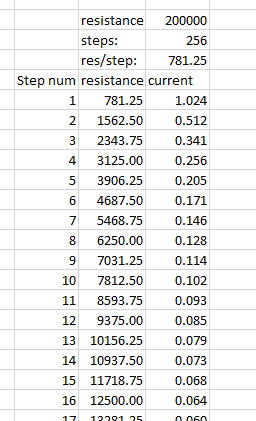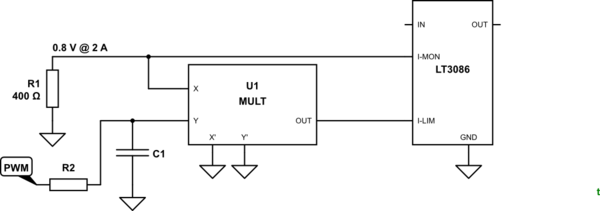In my project I am using a LT3086 (40V, 2.1A Low Dropout Adjustable Linear Regulator with Monitoring and Cable Drop Compensation )
With this voltage regulator you can "programm" the output current limit by connecting the pins Imon and Ilim and by setting the resistor Rmon to a correct value. (as shown in the picture above)
The relation between resistance Rmon and output current limit Ilim value is given by this equation (datasheet page 13):
Ilim = 800/Rmon
My goal would be to control the current limit between 5mA and 1A, where:
- Ilim = 1A at Rmon = 800 ohm
- Ilim = 5mA at Rmon = 160 kohm
My initial plan was to implement one digital potentiometer with a value 200K and with 256 steps (781.25 ohm/step). Since the equation for setting the current limit Ilim is not a linear function, you can not get a good resolution for the higher current values, but as you get higher in resistance the resolution gets better.
To counteract that, my plan is to implement a series of digital potentiometers (256 step) to simulate a digital logharithmic pot (I couldnt find any log pot that would sufice).

simulate this circuit – Schematic created using CircuitLab
And this would all work fine in ideal conditions...but the world is not ideal. 800 ohm resistor would be used if there was no wiper resistance and no 1. step resistance (when there is address 0). Wiper resistance can be between 75 and 300 ohms.
So by using 5 digital pots in series at address 0 and with the wiper resistances, in the best scenario, I would get around 1023 ohms.
R=75+3.9+75+19.5+75+39+75+195+75+390=1023.4375
By putting it in the equation, the maximum current limit and with that current at all, I could control with that would be:
Ilim = 800/1023 = 0.782 A
Which is far from 1 A.
Finally, the question:
How would I precisely compensate for the wiper+1.step resistance to get the resistance of 800 ohms, so I could set the current limit upto 1A?





